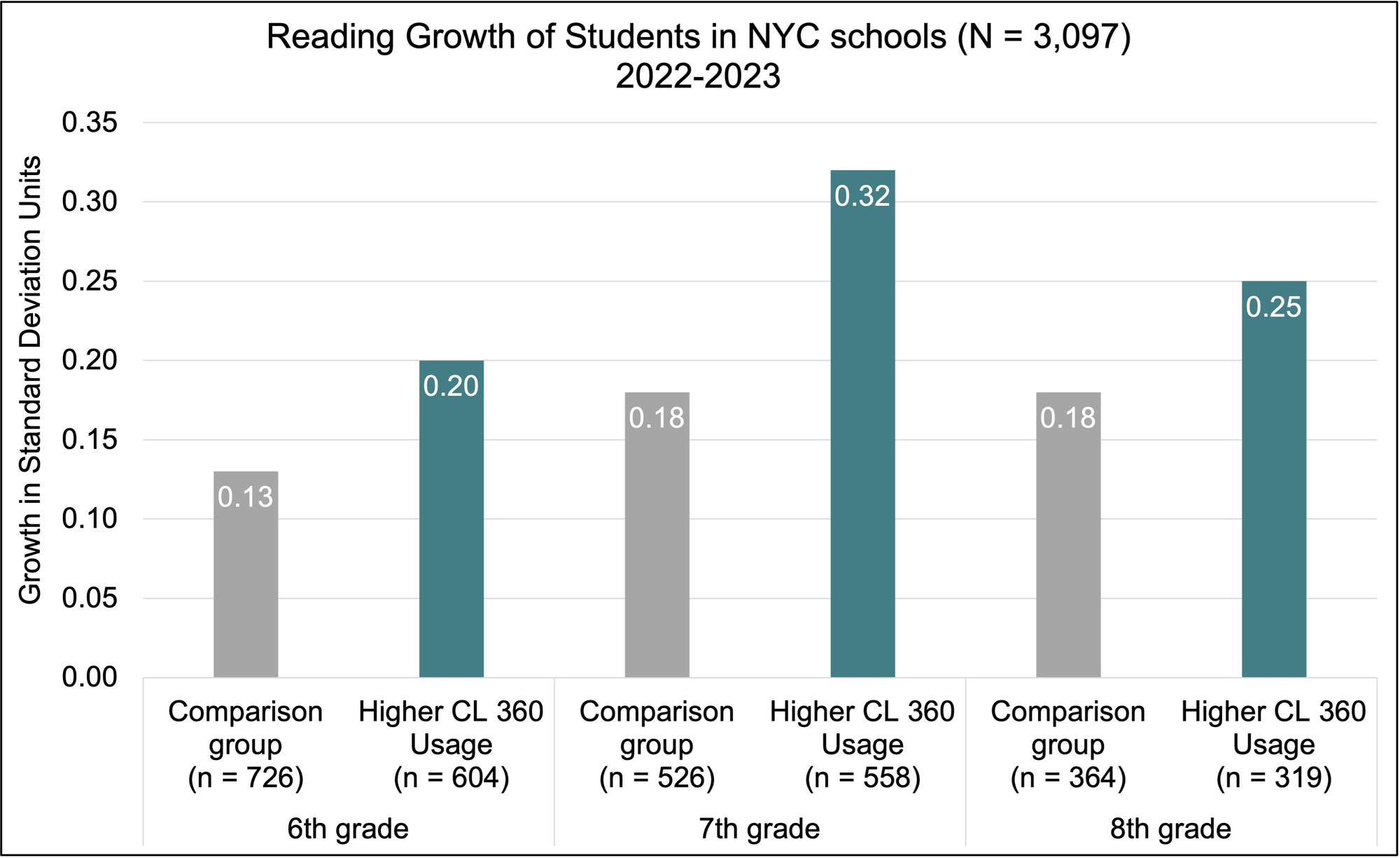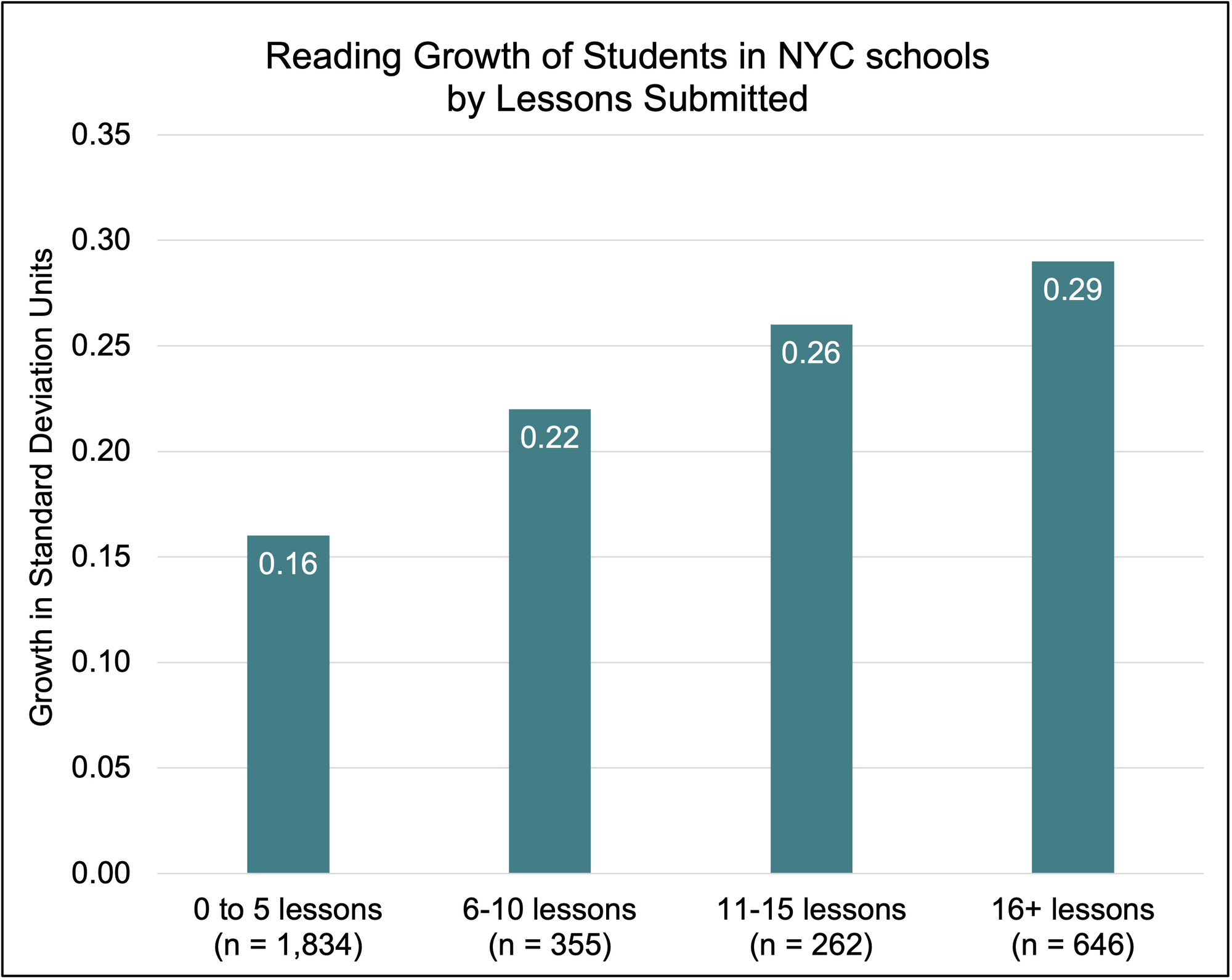Recent data from 26 NYC middle schools demonstrate a significant link between CommonLit 360 usage and students’ reading growth.
A new study of CommonLit 360 in 26 middle schools in New York City demonstrates the promise of the program to drive accelerated learning in English Language Arts (ELA). In all three grade levels (6th-8th), students who were exposed to CommonLit 360 materials at higher levels saw learning gains beyond what is typically expected in 1 year. These gains were seen for students at all levels.
About the Study
CommonLit 360 is CommonLit’s free ELA program that includes a year-long curriculum, assessments, professional development, and data dashboards. This comprehensive program has been available for teachers to use since the 2021-2022 school year, and several studies have demonstrated its effectiveness in accelerating students’ reading growth. A new study examining data from the 2022-2023 school year showed exciting gains, underscoring the promise of the program in helping schools accelerate learning and address long-standing achievement gaps.
In the study, CommonLit partnered with 26 schools in New York City to implement CommonLit 360. Through the partnership, these schools got access to the services offered in the School Essentials PRO package. This package supports successful school-wide implementation of CommonLit 360 through professional development for teachers, benchmark assessments to measure growth, administrator data dashboards, LMS integrations, and priority customer support.
The study sample included a total of 3,097 middle school students taught by 94 teachers in 26 NYC schools. Specifically, there were 1,330 6th graders, 1,084 7th graders, and 683 8th graders. Importantly, a majority of the schools in the sample enrolled students from traditionally underserved populations. For example, 23 out of 26 of the schools were designated as low-income (Title I eligible) schools. Additionally, 24 out of 26 of the schools enrolled 50% or more students who identified as Black and/or Hispanic (range = 50% - 98%, median = 91%). This sample also included students designated as English language learners (11%) or designated as being enrolled in a Special Education course (15%). Students who completed both the beginning-of-year and end-of-year CommonLit Assessments were included in the sample.
Key Finding #1: CommonLit 360 usage promoted additional months of learning over the annual expected reading gains for middle schoolers.
Students experienced reading growth predicted by their CommonLit 360 exposure (see Figure 1). This was true for all the grade level cohorts (6th-8th) in the study. Specifically, 6th graders who experienced CommonLit 360 materials at higher levels gained an additional 1.9 months of learning. This is a 21% improvement over the annual reading gains otherwise expected for 6th graders, based on seven nationally-normed reading tests (Bloom et al., 2008; Hill et al., 2008). Seventh graders who used CommonLit 360 to a greater degree gained an additional 5.4 months of learning, which is a 60% improvement over the annual reading gains expected for 7th graders. Finally, 8th graders who used CommonLit 360 to a greater extent gained an additional 2.3 months of learning, which is a 26% improvement over their expected annual reading gains.

Figure 1. The graph shows the effect size of the reading growth of 6th, 7th, and 8th grade students from beginning to end of the school year in standard deviation units. Students in the higher CL 360 usage group submitted 4 or more digital lessons, while students in the comparison group did not experience CommonLit 360 at meaningful levels.
Key Finding #2: The number of CommonLit 360 lessons students submitted predicted how much they grew from beginning to end of year.
The number of CommonLit 360 digital lessons submitted by a student significantly predicted their reading growth over the course of a school year. This means, the more lessons that a student submitted, the more reading growth they observed on average. To illustrate this significant relationship, Figure 2 shows students’ average reading growth at different levels of usage – those who submitted 0-5 lessons, 6-10 lessons, 11-15 lessons, and 16+ lessons.

Figure 2. The graph shows the effect size of students’ reading growth from beginning to end of the school year in standard deviation units based on how many CommonLit 360 digital lessons they submitted.
Importantly, this relationship held even after accounting for important factors including a student's prior performance, grade level, status as an English language learner, enrollment status in a Special Education course, and school’s Title I status. These results held also after accounting for the effect of a student’s teacher and school on their ELA outcomes. This means that the significant link between CommonLit 360 usage and reading growth cannot be attributed to a “teacher effect” (where certain teachers may be better at motivating students to engage with coursework) or a “school effect” (where certain schools may provide teachers and students with extra support).
Key Finding #3: Data suggest that CommonLit 360 helps all groups of students.
Results showed that traditionally underserved populations of students can benefit from CommonLit. The relationship between CommonLit 360 usage and students’ reading growth was not significantly different for traditionally underserved populations of students, such as English language learners, students with disabilities, and students enrolled in Title I schools. These results are exciting and suggest that CommonLit 360 can help all groups of students.
Get These Results in Your District
Interested in adopting CommonLit 360 in your school or district? Check out the tools to support CommonLit 360 implementation in our School Essentials PRO Plus Package.
What does this package include?
- Professional development for teachers, live and on demand
- Benchmark assessments to measure growth and unit skills assessments
- Administrator data dashboards to track data trends
- LMS integrations, including Canvas, Clever, and ClassLink
- A designated account manager and priority customer support
Talk to a CommonLit 360 specialist about our paid package options. We want to hear from you and help you get these results in your district!
References
Bloom, H. S., Hill, C. J., Black, A. R., & Lipsey, M. W. (2008). Performance trajectories and performance gaps as achievement effect-size benchmarks for educational interventions. Journal of Research on Educational Effectiveness, 1(4), 289-328.
Hill, C. J., Bloom, H. S., Black, A. R., & Lipsey, M. W. (2008). Empirical benchmarks for interpreting effect sizes in research. Child Development Perspectives, 2(3), 172-177.

